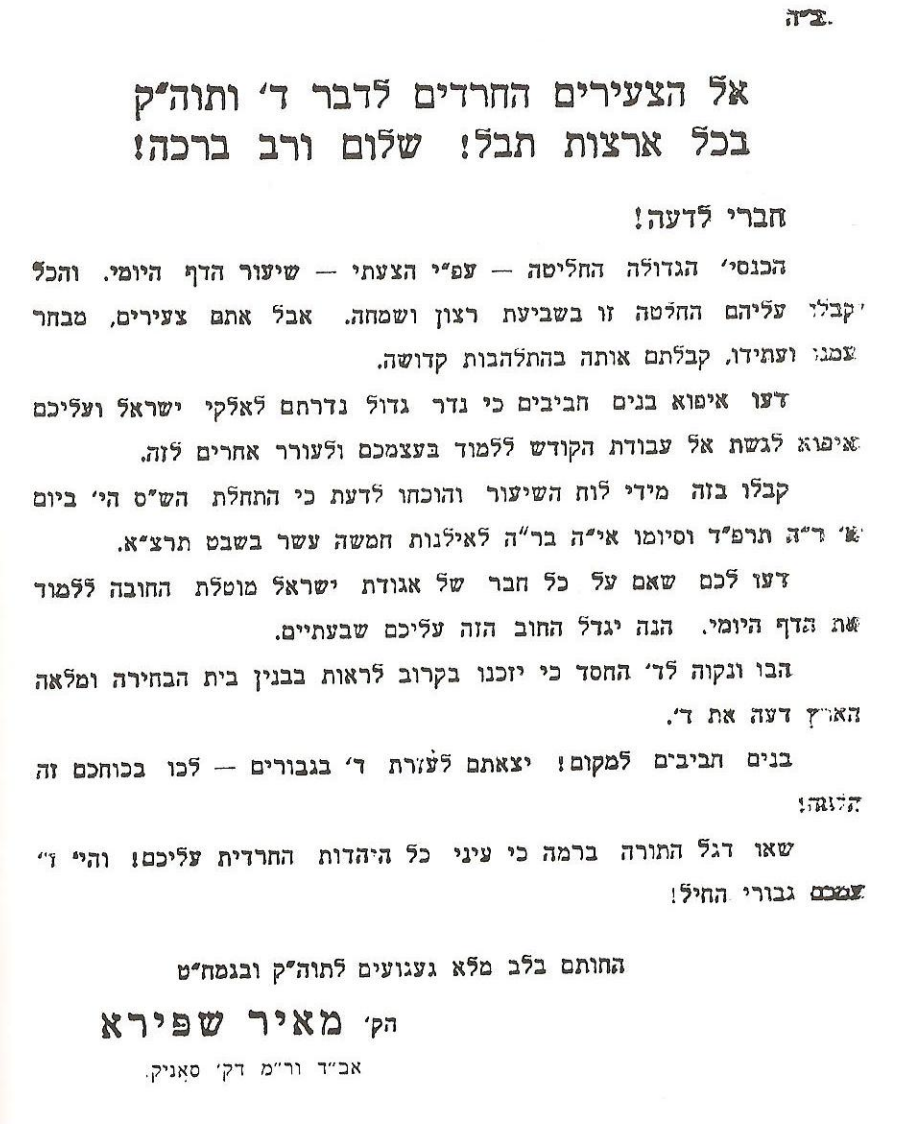Ready to get started?
Today’s Daf – Zevachim 115 / Jan. 7th, 2026 / י״ח בטבת תשפ״ו
Ready to get started?
🎉 Join the 2026/5786 #MegillahChallenge! 🎉
Register to join our Siyum Masechet Zevachim Sunday January 11
What Is the Daf Yomi?
The Daf Yomi (Daily Page) is a global initiative to study the entire Talmud Bavli—the Babylonian Talmud—over the course of 7.5 years. The pace is one daf (double-sided Talmud page) per day, following the pagination of the standard Vilna edition, which comprises 2,711 dapim (pages). The Daf Yomi includes all tractates of the Talmud Bavli, with the exception of those from Seder Zera’im (which has no Bavli coverage). There is, however, one exception: Masechet Shekalim, a tractate from the Talmud Yerushalmi (Jerusalem Talmud), which is included in the Daf Yomi cycle.
The Maharam Shapiro was the visionary who conceived and established the Daf Yomi project. A prominent leader of Polish Jewry, he was also one of the founders of the Lublin Yeshiva (Yeshivat Chachmei Lublin). From a young age, he was recognized as a brilliant scholar and was appointed rabbi of the Galina community in Galicia at just 23. He later served as a rabbi in Sanok, Piotrków, and Lublin.
He represented Agudat Yisrael in the Polish parliament and sat on the committee of the Polish Ministry of Religion. In 1924, he co-founded the Lublin Yeshiva and also composed many melodies (niggunim). Though he had no biological children, he would say he had two: the Lublin Yeshiva and the Daf Yomi.
He passed away young, at age 46, due to typhus. In 1958, his remains were brought from Poland to Har HaMenuchot in Jerusalem.
Rabbi Meir Shapiro founded Daf Yomi in 1923 in Poland, with the goal of increasing Torah study and fostering unity among Jews by providing a shared learning framework. He explained his inspiration came from studying the opening of Masechet Berachot, where he observed a unique thread of continuity across generations and continents:
“Everyone knows the Mishnah was composed in Eretz Yisrael, the Gemara in Babylonia, Rashi in Ashkenaz, Tosafot in France, the Maharsha in Lithuania, and the Maharam in Poland—and yet, all are asking the same question: ‘Tanna heicha kai?’ (“On what basis”, “Where is the source”)”
This, he said, revealed the “golden chain of unity” that ties Jewish learning across time and space.
With the support of major rabbinic figures like the Chafetz Chaim (Rabbi Yisrael Meir HaKohen) and the Rebbe of Ger, the initiative was launched enthusiastically across Jewish communities. The first cycle began on Rosh Hashanah 5684 (1923), and concluded on the night of Tu BiShvat 5691 (1931) at the Lublin Yeshiva.
At that celebration, Rabbi Shapiro recited the traditional Hadran (completion prayer) alongside Talmudic analysis and stories, and students composed a song based on the hadran text. The night was filled with dancing and joy.
Despite widespread rabbinic support, Daf Yomi has faced some critiques—most notably that it does not allow for in-depth study or review. Certain communities, like the Satmar Hasidim, have also opposed it due to its connection to Agudat Yisrael. Nevertheless, the initiative has many strengths: it encourages broad Talmud study, including less-learned tractates, fosters daily learning discipline, and has increased Torah learning worldwide.
Daf Yomi and Tisha B’Av
On Tisha B’Av, Torah study is generally prohibited as it brings joy—except for texts related to destruction and mourning. So how do Daf Yomi learners continue? Some split the page, learning half before the fast and half after. Others wait until the fast ends to study that day’s daf.
Daf Yomi and Masechet Shekalim
Though the Daf Yomi focuses on Talmud Bavli, it includes Masechet Shekalim from the Yerushalmi. Some early rabbinic authorities had access to a Bavli version of Shekalim, which has since been lost. As a result, publishers included the Yerushalmi version in Bavli printings.
Interestingly, differences exist between the Yerushalmi and Bavli printings of Shekalim. For example, the Yerushalmi version spans 13 pages, while the Bavli printing covers 22. In the first seven Daf Yomi cycles, Shekalim was studied using the Yerushalmi pagination, resulting in a total cycle of 2,702 dapim. Starting from the eighth cycle, learners switched to the Bavli pagination, increasing the total to 2,711 dapim.
Mishnayot in Daf Yomi
Although Daf Yomi is based on the Talmud Bavli, the learning cycle also includes two Mishnah tractates: Kinnim and Middot, which have no corresponding Gemara. It’s unclear why these were included while others—like Avot or tractates from Seder Zera’im—were not. The likely reason is that Kinnim and Middot are essential to understanding Seder Kodashim, which would feel incomplete without them.
There may also be a technical reason: in standard printings, Kinnim and Middot appear immediately after Masechet Me’ilah, continuing its page numbering, rather than starting from page 2 like other tractates.
Women and Daf Yomi
Today, thousands of Jews learn the Daf Yomi—independently, in groups, or through daily shiurim. Thirteen complete Daf Yomi cycles have been celebrated so far. The first Global Siyum HaShas (Talmud completion ceremony) held by women took place in Jerusalem in January 2020 (5780), with 3,300 women participating.
Other Daily Learning Initiatives
Inspired by Daf Yomi, several other daily learning projects have been established. In 1979, the Rebbe of Ger launched the Daf Yomi Yerushalmi—a daily study cycle of the Jerusalem Talmud, which spans about 4.5 years.
Other popular daily programs include: Rambam Yomi – Daily study of Rambam’s Mishneh Torah, Mishnah Yomit – Daily Mishnah study, Halacha Yomit – Daily halachic learning, Perek Tanakh Yomi – A chapter a day of Tanakh.
📅 Curious about what daf is being studied today?
📥 Want to start your daily learning journey?
Subscribe to Daf Yomi Here (free)


